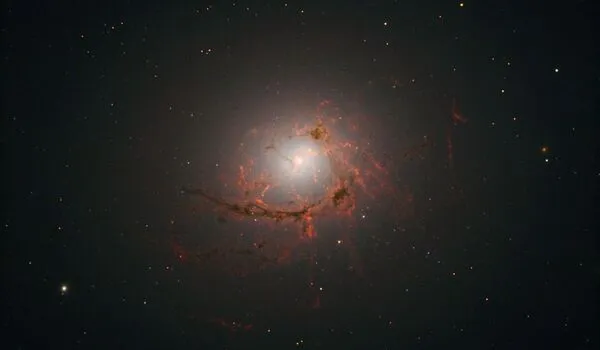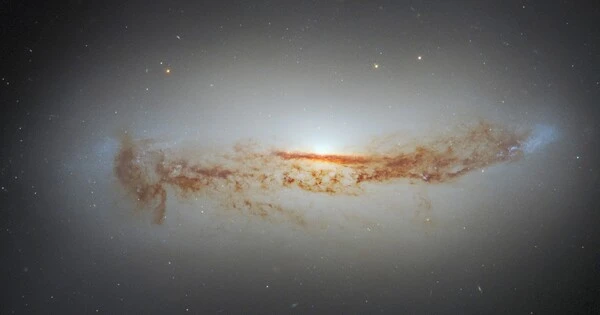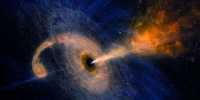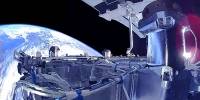Astronomers have discovered a rapidly expanding black hole in the early universe, which is thought to be a crucial “missing link” between young star-forming galaxies and the first supermassive black holes. They made this discovery using data from NASA’s Hubble Space Telescope. Until now, the GNz7q monster had gone unnoticed in one of the most well-studied areas of the night sky, the Great Observatories Origins Deep Survey-North (GOODS-North) field.
The team used archival Hubble data from Hubble’s Advanced Camera for Surveys to determine that GNz7q existed only 750 million years after the big bang. The researchers discovered evidence that GNz7q is a newly formed black hole. Hubble discovered a compact source of UV and infrared light. This couldn’t be caused by emission from galaxies, but is consistent with the radiation expected from materials that are falling onto a black hole.
Rapidly growing black holes in dusty, early star-forming galaxies are predicted by theories and computer simulations, but had not been observed until now.
“Our analysis suggests that GNz7q is the first example of a rapidly growing black hole in the dusty core of a starburst galaxy at an epoch close to the earliest supermassive black hole known in the universe,” explained Seiji Fujimoto, an astronomer at the Niels Bohr Institute of the University of Copenhagen and lead author of the Nature paper describing this discovery. “The object’s properties across the electromagnetic spectrum are in excellent agreement with predictions from theoretical simulations.”
GNz7q provides a direct connection between these two rare populations and provides a new avenue toward understanding the rapid growth of supermassive black holes in the early days of the universe. Our discovery provides an example of precursors to the supermassive black holes we observe at later epochs.
Seiji Fujimoto
One of today’s outstanding mysteries in astronomy is how supermassive black holes, weighing millions to billions of times the mass of the Sun, became so massive so quickly.
According to current theories, supermassive black holes form in the dusty cores of vigorously star-forming “starburst” galaxies before expelling the surrounding gas and dust and emerging as extremely luminous quasars. Both dusty starburst galaxies and luminous quasars have been discovered in the early universe, despite being extremely rare.
The researchers believe that GNz7q could be the missing link between these two types of objects. GNz7q has both the dusty starburst galaxy and the quasar, with the quasar light revealing the dust’s reddened color. Furthermore, GNz7q lacks several features that are typically observed in typical, very luminous quasars (corresponding to the emission from the supermassive black hole’s accretion disk), which is most likely explained by the fact that the central black hole in GN7q is still in a young and less massive phase. These properties are identical to those of a young, transition phase quasar predicted in simulations but never observed in a similarly high-redshift universe as the very luminous quasars identified up to a redshift of 7.6.

“GNz7q provides a direct connection between these two rare populations and provides a new avenue toward understanding the rapid growth of supermassive black holes in the early days of the universe,” continued Fujimoto. “Our discovery provides an example of precursors to the supermassive black holes we observe at later epochs.”
While other interpretations of the team’s data cannot be completely ruled out, the observed properties of GNz7q are in strong agreement with theoretical predictions. GNz7q’s host galaxy is forming stars at the rate of 1,600 solar masses per year, and GNz7q itself appears bright at UV wavelengths but very faint at X-ray wavelengths.
A massive black hole’s accretion disk should be very bright in both UV and X-ray light. However, while the team detected UV light with Hubble, X-ray light was invisible even with one of the most extensive X-ray datasets. These findings indicate that the core of the accretion disk, where X-rays originate, is still obscured, whereas the outer part of the accretion disk, where UV light originates, is becoming clear. According to this interpretation, GNz7q is a rapidly expanding black hole that is still obscured by the dusty core of its star-forming host galaxy.
“GNz7q is a unique discovery that was found just at the center of a famous, well-studied sky field — it shows that big discoveries can often be hidden just in front of you,” commented Gabriel Brammer, another astronomer from the Niels Bohr Institute of the University of Copenhagen and a member of the team behind this result. “It’s unlikely that discovering GNz7q within the relatively small GOODS-North survey area was just ‘dumb luck,’ but rather that the prevalence of such sources may in fact be significantly higher than previously thought.”
Finding GNz7q in plain sight was only possible thanks to GOODS-uniquely North’s detailed multiwavelength datasets. Without this wealth of data, GNz7q would have been easy to overlook, as it lacks the distinguishing features that are typically used to identify quasars in the early universe. The team now hopes to conduct systematic searches for similar objects using dedicated high-resolution surveys, as well as use the NASA James Webb Space Telescope’s spectroscopic instruments to study objects like GNz7q in unprecedented detail.
“With the James Webb Space Telescope, we will be able to fully characterize these objects and probe their evolution and underlying physics in much greater detail,” Fujimoto concluded. “Once operational, Webb will be able to determine definitively how common these rapidly expanding black holes truly are.”
















